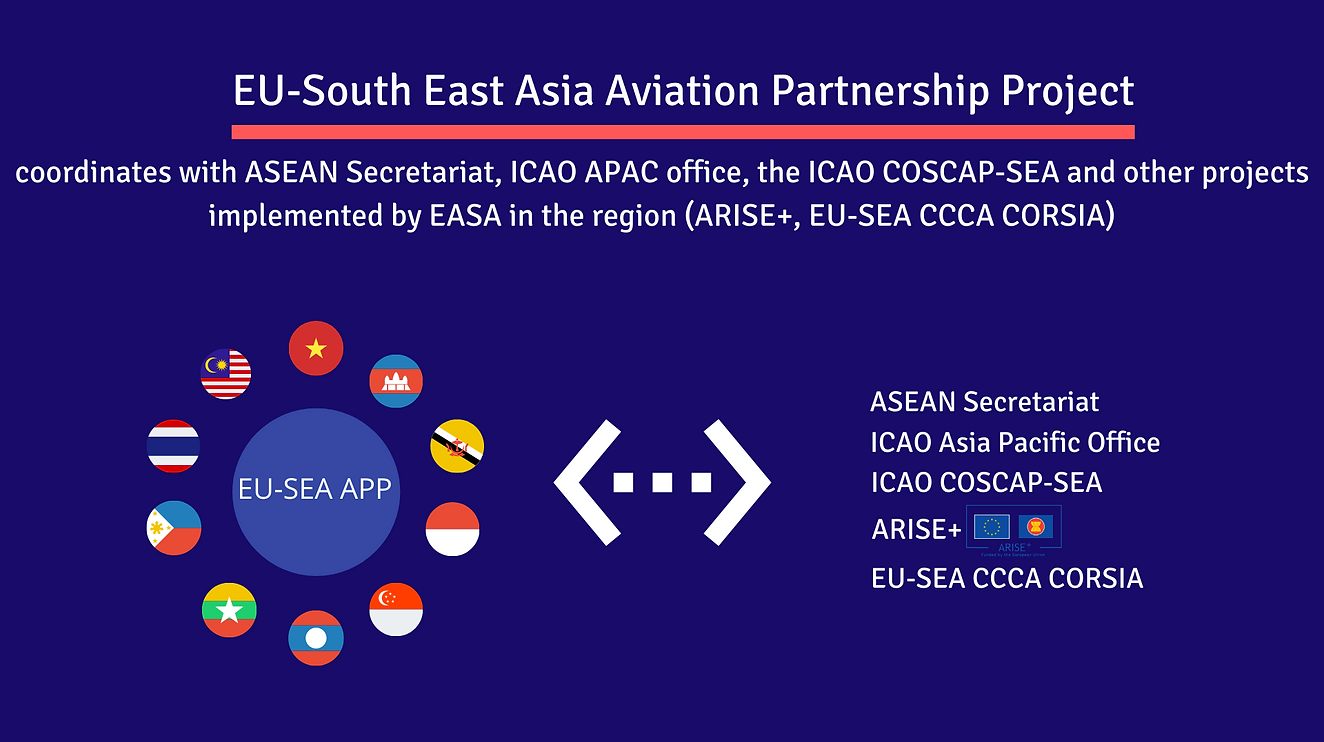The EU-South East Asia Aviation Partnership Project (EU-SEA APP) was funded by the European Union (EU) and implemented by the European Union Aviation Safety Agency (EASA) to enhance political, economic, and environmental partnership between South East Asia and the EU in the field of civil aviation.
The specific objectives (outcomes) of the EU-SEA APP were the following:
- enhanced policy dialogue and stronger institutional links;
- safer and more harmonised market for aviation industry; and
- raised standard of environmental protection and climate change action.

EASA implemented the EU-SEA APP on behalf of the European Commission. The project's partner countries were the ten members of ASEAN: Brunei, Cambodia, Indonesia, Laos, Malaysia, Myanmar, Philippines, Singapore, Thailand, and Vietnam. ASEAN has a combined population of approximately 625 million people or 8.8% of the world's population.
Air travel to, from, and within the region is projected to grow at an average annual growth rate of 6.6% over the next 20 years, as passenger demand is stimulated by low-cost carriers with low fares and new routes.
The EU-SEA APP coordinated its activities with the ARISE Plus Civil Aviation Project, the EU-SEA CCCA CORSIA Project, the ASEAN Secretariat, the ICAO Asia and Pacific (APAC) Office, and the ICAO Co-operative Development of Operational Safety and Continuing Airworthiness Programme – South East Asia (COSCAP-SEA).
Main Achievements
The EU-SEA APP successfully contributed to meeting its own objectives through the following achievements:
Enhanced policy dialogue and stronger institutional links
- Enhancement of policies and institutional links through participation of EU experts and leaders in regional and bilateral symposia, workshops, and fora (e.g. ICAO, ASEAN, industry) and of ASEAN experts in EU fora (e.g. EASA).
- Negotiation, conclusion, and maintenance of Memoranda of Understanding MoUS with the Air Traffic Management Research Institute (ATMRI), Indonesia, and Singapore, and of Working Arrangements (Singapore), leading to enhanced cooperation frameworks and reduced duplication of safety oversight.
- Fostered links with international organisations (ICAO) and educational institutions through joint events, seminars, and exchanges of expertise on new/emerging technologies.
Reduced market barriers for EU aviation industry
- Removal of regulatory barriers and a safer operating environment for EU citizens and products by enhancing safety oversight processes and increasing qualification and expertise of competent authority staff.
- Increased actual capacity and potential capacity by enabling infrastructure enhancement through technical procedures and the adoption of new technologies and methods (e.g. performance-based navigation (PBN), remote towers, flexible use of airspace).
- Targeted response to EU industry safety concerns over SEA regulators on operational training, such as safety culture within helicopter operators, runway safety, upset prevention and recovery training (UPRT), competency-based training and assessment (CBTA), and evidence-based training (EBT).
- Greater harmonisation with and increased uptake of EU standards linked to both traditional fields (e.g. design organisation approval (DOA), production organisation approval (POA)) and new and emerging technologies (e.g. unmanned aircraft systems (UAS) / urban air mobility (UAM), drones, vertiports, U-space).
- Greater awareness and acceptance of EU positions on topics such as cybersecurity, enhanced processes for developing and implementing appropriate IT systems' security and reliability, as well as a structured introduction to artificial intelligence (AI) for aviation (e.g. Cybersecurity, AI aviation models).
Raised standard of environmental protection and climate change action
-
Pioneered environmental protection ahead of the EU-South East Asia Cooperation on Mitigating Climate Change impact from Civil Aviation (EU-SEA CCCA CORSIA Project), environmental management system (EMS) for airports, aviation environmental database management, and monitoring, reporting and verification (MRV).
EU-SEA APP explained
Technical Cooperation Project Details
Project Manager: sandro.fabbrini [at] easa.europa.eu (sandro[dot]fabbrini[at]easa[dot]europa[dot]eu)
Operational Manager: david.waller [at] easa.europa.eu
Project Assistant: alberto.soccol [at] easa.europa.eu (alberto[dot]soccol[at]easa[dot]europa[dot]eu)